Barnard’s Star is a red dwarf located only 5.9629 light-years away in the constellation Ophiuchus. It is the fourth closest individual star to Earth, after the three components of the Alpha Centauri system.
With an apparent magnitude of 9.511, the low-mass star is invisible to the unaided eye and can only be seen in a telescope. It was named after the American astronomer Edward Emerson Barnard, who measured its proper motion in 1916.
In 2024, an international team of astronomers discovered Barnard’s Star b, a low-mass exoplanet orbiting close to the star. Barnard b is one of the lowest-mass exoplanets discovered to date.
In 2025, astronomers confirmed three more planets orbiting the star. All four planets are sub-Earths more massive than Mars, with minimum masses in the range from 0.19 to 0.34 Earth masses. None of them orbit in the habitable zone of Barnard’s Star. The fourth planet, Barnard’s Star e, is the least massive extrasolar planet discovered using the radial velocity method.
Star type
Barnard’s Star is a red main sequence star of the spectral type M4.0V. It is much smaller, less massive, and cooler than the Sun. The red dwarf has a mass of only 0.162 solar masses and a radius of 0.187 solar radii. This makes the star closer in size to Jupiter than to the Sun, even though it has a mass over 100 times that of the gas giant.
Barnard’s Star has a surface temperature of about 3,195 K and a bolometric luminosity of 0.00340 solar luminosities. Most of its energy output is in the infrared band. The star’s luminosity in the visible part of the spectrum is only 0.0004 solar luminosities.
To illustrate, if Barnard’s Star were placed at the centre of the solar system, it would be only 100 times brighter than the full Moon. The Sun would be this dim if it were located at 80 times its present distance.
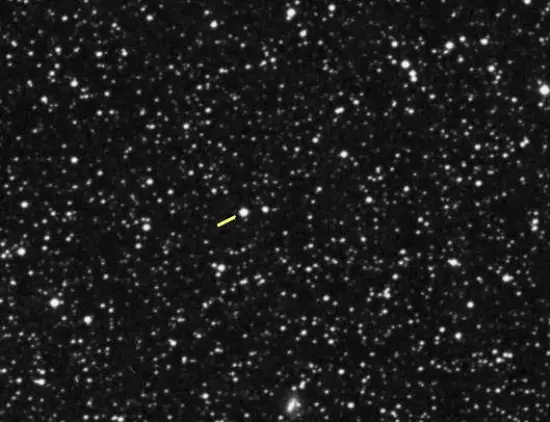
Barnard’s Star in NASA’s digital star survey (PD)
The red dwarf star has lost a lot of its rotational energy and takes 142 days to complete a rotation. In comparison, the Sun takes 25 days. The estimated age of Barnard’s Star is about 10 billion years, more than twice that of the Sun. The red dwarf may be one of the oldest stars in the Milky Way galaxy.
Even though it is an old star, Barnard’s Star still experiences flare events and exhibits low-level magnetic activity. It shows coronal X-ray emission and moderately strong emissions in the ultraviolet band.
Despite being twice as old as the Sun, due to its low mass Barnard’s Star will still be on the main sequence long after our host star is gone. The life cycle of low-mass stars lasts much longer because these stars are fully convective and do not accumulate helium in their cores. As a result, they can fuse their entire supply of hydrogen, not just that in the core, and stay on the main sequence for trillions of years.
With a mass of 0.162 solar masses, Barnard’s Star may stay on the main sequence for over 2 trillion years, followed by a few billion years as a blue dwarf and finally a white dwarf.
Blue dwarfs are a hypothetical class since the universe is not old enough for any star to have reached this stage. When Barnard’s Star evolves into a blue dwarf, it will have a surface temperature of 6,500 – 8,500 K and shine with a third of the Sun’s luminosity.
Barnard’s Star has only between 10 and 32% of the Sun’s metal content, i.e. elements heavier than hydrogen and helium. It is an intermediate population II star, with a higher metallicity than stars in the Milky Way’s halo and lower than most disk stars.
However, more recent studies estimate a higher metal content for the star, between 75% and 125% of the Sun’s metallicity. A 2024 study found a metallicity of −0.56 ± 0.07 cgs based on the data obtained with the Echelle SPectrograph for Rocky Exoplanets and Stable Spectroscopic Observations (ESPRESSO).
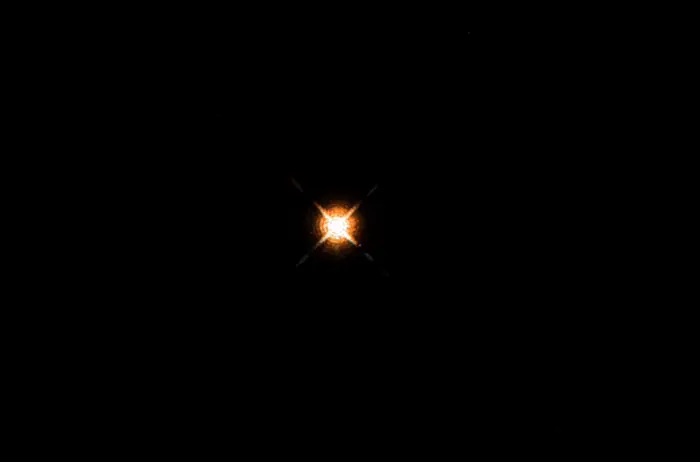
Barnard’s Star captured by the Hubble Space Telescope. Image credit: NASA/ESA/Hubble Heritage & C. Violette (CC BY-SA 4.0)
Barnard’s Star is classified as a flare star of the BY Draconis type. It has the variable star designation V2500 Ophiuchi. BY Draconis variables are typically class K and M main sequence stars whose brightness changes due to starspots coupled with the effects of rotation. The periods of variability are linked with the stars’ rotational rates.
Many other nearby red and orange dwarfs exhibit similar variations, including Lalande 21185 in the constellation Ursa Major, Ross 248 in Andromeda, AX Microscopii (Lacaille 8760) in Microscopium, Kapteyn’s Star (VZ Pictoris) in Pictor, and Bessel’s Star (61 Cygni A) in Cygnus. BY Draconis stars may exhibit stellar flares and show additional brightness fluctuations of the UV Ceti type.
A 1998 photometric study of Barnard’s Star with the Hubble Space Telescope Fine Guidance Sensor 3 found very weak evidence of brightness variations with a period of about 130 days, corresponding to the star’s rotational rate. The scientists identified a possible single, small spot decreasing in size, that might be causing the fluctuations coupled with rotational modulation.
On July 17, 1998, a team of astronomers led by Diane Paulson of NASA’s Goddard Space Flight Center in Maryland detected an intense stellar flare from Barnard’s Star. The team observed the star with a high-resolution spectrograph as part of a planet-hunting project. The large flare increased the star’s brightness and surprised astronomers because old red dwarfs tend to be quiescent and flares of this magnitude are quite rare.
The scientists estimated a temperature of at least 8,000 K for the flaring region in the lower atmosphere, more than double the star’s normal temperature (3,195 K). The flare lasted for at least an hour and caused an increase in the star’s brightness of at least half a magnitude in visual wavelengths.
Flares this large would have implications for any planets orbiting in the star’s habitable zone. The zone is quite close to the star and the planets would be strongly affected by the flares. The habitable zone is defined as the distance from the host star at which liquid water can exist on a planet’s surface. In the Barnard’s Star system, the zone is quite close to the star and the planets would be strongly affected by the flares.
The discovery of the large flare meant that the three nearest red dwarfs to the Sun – Proxima Centauri, Barnard’s Star, and Wolf 359 – were all flare stars. However, Proxima and Wolf 359 are much younger and more active stars, and their flares were detected more than half a century ago. Proxima was discovered to be a flare star in 1951, and Wolf 359 in 1969.
In 2019, two stellar flares coming from Barnard’s Star were detected in the ultraviolet band. Additionally, an X-ray flare was observed that released 1.6 x 1022 joules. Each UV flare had an energy of 3 x 1022 joules in the far ultraviolet. The flares were reported by a team led by Kevin France of University of Colorado. The UV flares were detected by the Hubble Space Telescope and the X-ray flare was discovered by the Chandra X-ray Observatory.
The researchers analyzed the effects of the flares on the atmospheric stability of hypothetical terrestrial planets in the star’s habitable zone. They concluded that sustained exposure to the flares from Barnard’s Star would result in the loss of about 87 Earth atmospheres per billion years through thermal processes and about 3 Earth atmospheres per billion years through ion loss processes.
Low-level variability in the star’s radial velocity was reported in 2003. The variations were mostly due to secular acceleration and stellar activity.
Based on high-precision radial velocity monitoring of the star over a period of 2.5 years, a team of astronomers led by M. Kürster determined upper limits to the mass of hypothetical planets orbiting the star. For the separation of 0.017 to 0.98 astronomical units, they excluded any planets with a true mass of more than 0.86 Jupiter masses. For the habitable zone, at a separation of 0.034 to 0.082 astronomical units, they excluded planets with a mass of over 3.1 times that of Neptune.
Planets
Barnard’s Star has four orbiting planets, confirmed in 2024 and 2025. They are designated Barnard’s Star b (Barnard b), c, d, and e.
Barnard’s Star b was the first planet to be confirmed. The planet has a mass at least 37% that of Earth and orbits the parent star with a period of 3.15 days. Its existence was confirmed based on data obtained with the ESPRESSO spectrograph on the Very Large Telescope (VLT).
The same study found evidence for three other low-mass planets orbiting the star.
In March 2025, an independent study confirmed the presence of both Barnard b and the three new candidate planets. The astronomers also ruled out the presence of any planets with masses of more than 0.57 Earth masses in the habitable zone of the host star.
All four planets orbit close to Barnard’s Star, with orbital periods of only 2.34 (Barnard d), 3.15 (Barnard b), 4.12 (Barnard c), and 6.74 days (Barnard e). Any hypothetical planets orbiting in the star’s habitable zone would have periods of 10 to 42 days.
The planetary system of Barnard’s Star is one of the most compact known among late-type red dwarfs that host low-mass planets.
Barnard’s Star b
In 2024, an international team of astronomers led by Jonay González Hernández and Alejandro Suárez Mascareño, researchers at the Instituto de Astrofísica de Canarias in Spain, announced the discovery of Barnard’s Star b, a sub-Earth with about half the mass of Venus.
Barnard b is the first of the four planets confirmed to be orbiting Barnard’s Star. It is the second innermost planet in the system, after Barnard d.
The discovery of this planet was made using data obtained with the Echelle SPectrograph for Rocky Exoplanets and Stable Spectroscopic Observations (ESPRESSO) on the Very Large Telescope (VLT) at the Paranal Observatory in the Atacama Desert in Chile. Astronomers used a set of 156 observations carried out over four years to explore periods shorter than 50 days, which includes the habitable zone of Barnard’s Star. Barnard’s Star was the primary target of the ESPRESSO observations, but the astronomers also aimed to detect other Earth-like exoplanets in the habitable zones of nearby stars.
The results are supported by the data obtained with the European Southern Observatory’s High Accuracy Radial Velocity Planet Searcher (HARPS) at the La Silla Observatory in Chile, the High Accuracy Radial velocity Planet Searcher for the Northern hemisphere (HARPS-N) at the Roque de los Muchachos Observatory on the Canary Islands in Spain, and in the CARMENES survey (Calar Alto high-Resolution search for M-dwarfs with Exoearths with Near-infrared and optical Échelle Spectrographs) with the 3.5-metre telescope at the Calar Alto Observatory in Spain.
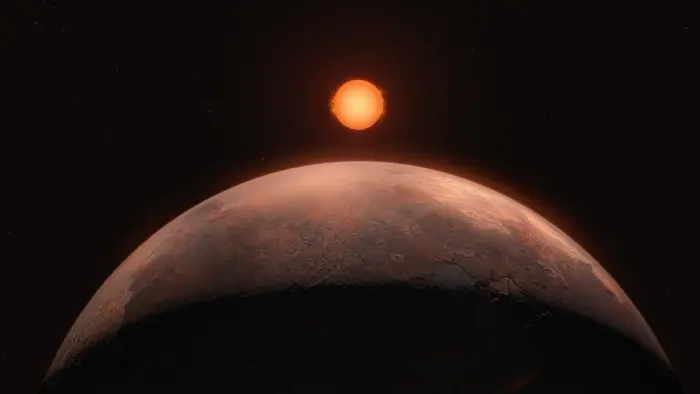
This artist’s impression shows Barnard b, a sub-Earth-mass planet that was discovered orbiting Barnard’s Star. Its signal was detected with the ESPRESSO instrument on ESO’s Very Large Telescope (VLT), and astronomers were able to confirm it with data from other instruments. An earlier promising detection in 2018 around the same star could not be confirmed by these data. On this newly discovered exoplanet, which has at least half the mass of Venus but is too hot to support liquid water, a year lasts just over three Earth days. Image credit: ESO/M. Kornmesser (CC BY 4.0)
The exoplanet orbits Barnard’s Star with a period of 3.1542 ± 0.0004 Earth days at a distance of only 0.0229 ± 0.0003 astronomical units (Earth – Sun distances) or 1.8 million miles. This corresponds to about 5% the distance from Mercury to the Sun.
Barnard b has a minimum mass of 0.299 ± 0.026 Earth masses, more than double the mass of Mars. It has an equilibrium temperature of 438 K (compared to the Earth’s 255 K). It is one of the few extrasolar planets known with a mass less than that of Earth.
The same study proposed three other possible exoplanets. The candidate low-mass planets orbit too close to the star to be habitable. Even though Barnard’s Star is about 2,600 K cooler than the Sun, any planet orbiting close to it would be too hot to sustain liquid water on its surface.
The study was published in the journal Astronomy & Astrophysics, Volume 690, in October 2024.
Barnard’s Star c
Barnard’s Star c is the second outermost planet confirmed to be orbiting Barnard’s Star, after Barnard’s Star e. It has a minimum mass of 0.335 ± 0.030 Earth masses and orbits Barnard’s Star with a period of 4.1244 ± 0.0006 days at a distance of 0.0274 ± 0.0004 astronomical units. It has the largest eccentricity (0.08) of the four planets.
Barnard’s Star c, d and e were confirmed by a team of astronomers led by Ritvik Basant at the University of Chicago based on data obtained with MAROON-X (M-dwarf Advanced Radial velocity Observer Of Neighboring eXoplanets), a high precision radial velocity spectrograph on the 8-metre Gemini North Telescope on Mauna Kea, Hawaii.
The team obtained 112 radial velocity measurements from 2021 to 2023. They also confirmed Barnard b and combined the MAROON-X data with the data previously obtained with the ESPRESSO instrument to confirm the presence of Barnard e, the fourth planet orbiting Barnard’s Star. The three inner planets were confirmed using the MAROON-X data alone.
Barnard’s Star d
Barnard’s Star d is the innermost planet known to be orbiting Barnard’s Star. It has a mass of at least 0.263 ± 0.024 Earth masses and an orbital period of 2.3402 ± 0.0003 days. It orbits the host star at a distance of 0.0188 ± 0.0003 AU with an eccentricity of 0.04.
Barnard’s Star e
Barnard’s Star e is the outermost planet orbiting Barnard’s Star. It has an orbital period of 6.7392 ± 0.0028 days and an eccentricity of 0.04. It orbits at a distance of only 0.0381 ± 0.0005 AU.
Barnard e is the least massive extrasolar planet ever detected using the radial velocity method. It has a minimum mass of 0.193 ± 0.033 Earth masses. In comparison, Proxima d, the inner planet orbiting Proxima Centauri, has an estimated mass of at least 0.26 Earth masses. Proxima d is considered among the lightest exoplanets discovered by radial velocity.
Planet search
As the second-closest stellar system to Earth, Barnard’s Star is a frequent target for the search for extrasolar planets. Even though the first exoplanet was not confirmed before 2024, several candidate planets were reported in the past century.
In the 1960s and early 1970s, the Dutch astronomer Peter van de Kamp of Swarthmore College claimed that he had detected an astrometric wobble, which he attributed to a planet, using a 24-inch refractor at Sproul Observatory.
Van de Kamp initially proposed a planet with about 1.6 Jupiter masses orbiting the host star at a distance of 4.4 astronomical units (AU), but he later revised his measurements and even proposed a second planet.
Van de Kamp’s claims were widely accepted until 1973, when two papers failed to confirm the planet’s existence. One of these, authored by John L. Hershey of Swarthmore, suggested that variations in the astrometric fields of stars corresponded to the timing of the modifications that had been done on the objective lens of the Swarthmore refractor.
In 1995, American astronomer George Gatewood proposed that companions with a mass 10 times that of Jupiter could not exist around Barnard’s Star.
Interferometric observations with NASA’s Hubble Space Telescope Fine Guidance Sensor 3 in 1999 did not detect any planets. However, astronomers were able to exclude the existence of planets with a mass of more than 0.8 Jupiter masses orbiting the star with periods between 1 and 1,000 Earth days.
A 2013 paper placed further limits on the mass of possible planets orbiting Barnard’s Star. The researchers determined an upper limit of 2 Earth masses for planets orbiting the star with periods of up to 1,000 days. They also excluded planets with more than 10 Earth masses orbiting with periods of up to 2 years. The habitable zone of Barnard’s Star was found to be devoid of Earth-mass or larger planets, with the possible exception of hypothetical planets in face-on orbits.
A super-Earth planet was reported to be orbiting Barnard’s Star in November 2018. Designated Barnard’s Star b (the designation now applies to the confirmed planet and not the disputed 2018 candidate), the exoplanet was believed to have a mass of at least 3.2 Earth masses and orbit at a maximum angular separation of 220 milliarcseconds from its parent star.
The detection was announced in a paper published in the journal Nature. It was credited to the CARMENES (Calar Alto high-Resolution search for M dwarfs with Exoearths with Near-infrared and optical Echelle Spectrographs) and Red Dots projects, both aiming to find the nearest terrestrial planets to the Sun.
The team that detected the candidate planet was led by Ignasi Ribas of the Institute of Space Studies of Catalonia and the Institute of Space Sciences, CSIC in Spain. They used data collected by seven different instruments, including ESO’s HARPS and UVES spectrographs, over a period of 20 years. The team detected the planet using the radial velocity method. They also found a wobble that may indicate another planet that orbits much farther out.
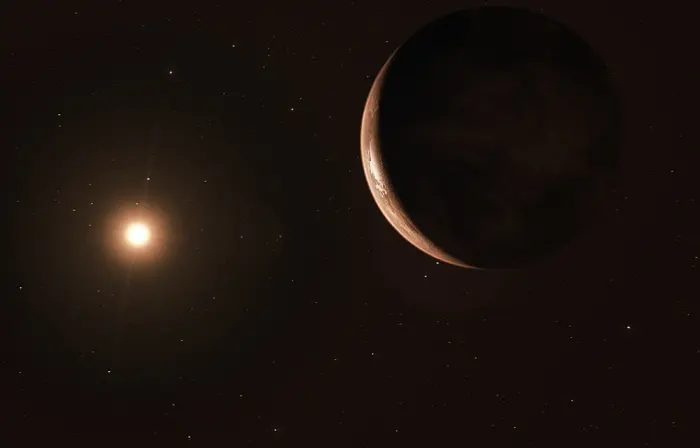
An artist’s impression of Barnard’s Star b, image credit: ESO/M. Kornmesser (CC BY 4.0)
For the former Barnard’s Star b, the astronomers found an orbital period of 233 days and a distance of only 0.4 astronomical units from Barnard’s Star. This would mean that the proposed planet is close to the snow line and receives only 2% of the energy from its host star that the Earth gets from the Sun. With an equilibrium temperature as low as -170° C, the planet would not be suitable to host life as we know it.
The same study was used to set more accurate upper mass limits for any potential planets orbiting in the star’s habitable zone. The researchers’ analysis was sensitive to planets with masses of at least 0.7 and 1.2 Earth masses at respective orbital periods of 10 and 40 days. The periods correspond to the inner and outer edges of the star’s habitable zone. Hence any planets that may yet be discovered in the goldilocks zone should be less massive.
The existence of Barnard’s Star b came into question after a study published in July 2021. A team led by Jack Lubin at the University of California, Irvine (UCI), used archival data and measurements obtained with the Habitable-Zone Planet Finder (HPF) instrument at McDonald Observatory in Texas and determined that the signal interpreted as the candidate planet was in fact an alias of the star’s 145-day rotation period. They found that the 233-day signal was the strongest only when stellar activity on the surface of Barnard’s Star was also strong.
A 2022 study used data obtained with SPIRou, an infrared high-resolution echelle spectropolarimeter on the Canada–France–Hawaii Telescope on Mauna Kea in Hawaii, and confirmed that Barnard’s Star b was an artifact produced by a combination of stellar activity and time sampling.
Facts
Barnard’s Star is one of the most studied stars in the solar neighbourhood. Its location near the celestial equator makes it easy to observe from both hemispheres. Astronomers have mainly focused on determining its stellar parameters and motion, and on finding orbiting planets.
E. E. Barnard was the first to measure the star’s proper motion in 1916. Barnard compared his photograph with one taken in 1904 and found an annual motion of 10”.36. This was the largest proper motion known for any star.
Barnard was not the first to image the star. The red dwarf had previously been captured on Harvard University photographic plates in 1888 and 1890.
Barnard’s Star still has the largest proper motion of any star discovered to date. It appears to move across the sky at 10.358 seconds of arc per year relative to the Sun, corresponding to a relative lateral speed of 90 km/s. This amounts to a quarter of a degree over the course of a human lifetime, or about half the angular diameter of the full Moon.
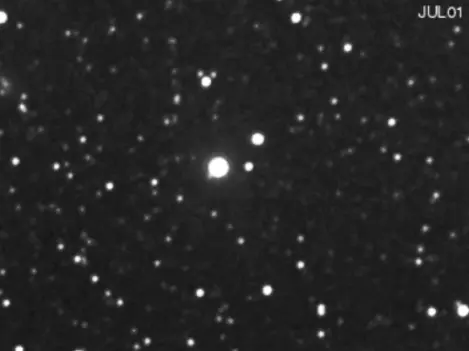
Barnard’s Star positions between 2001 and 2010, credit: Alejandro Sanz Gómez (CC BY-SA 2.5 ES)
High proper motion usually indicates that a star lies in the solar neighbourhood. Proxima Centauri, the nearest star to the Sun, moves at 3.853 arc seconds per year.
Most stars travel across the sky at 0.01 arc seconds or less per year and appear to stay in the same place over millennia. Other than Barnard’s Star, the highest proper motion stars known are Kapteyn’s Star, a red dwarf 12.83 light-years away in the constellation Pictor, Groombridge 1830 (Argelander’s Star), a yellow subdwarf 29.93 light-years away in Ursa Major, and Lacaille 9352, a red dwarf 10.72 light-years away in Piscis Austrinus. These stars travel at 8.671″ yr-1, 7.058″ yr-1, and 6.896″ yr-1 respectively.
The highest proper motion stars visible to the unaided eye are Groombridge 1830 (mag. 6.44), 61 Cygni A and B (mag. 5.21 and 6.05), and Epsilon Indi (mag. 4.83), with respective proper motions of 7.058″ yr-1, 5.281″ yr-1 and 5.172″ yr-1, and 4.704″ yr-1.
Barnard’s Star has a radial velocity of -110 km/s towards the Sun. Combined with the star’s high proper motion, this yields a space velocity of -142.6 ± 0.2 km/s.
Barnard’s Star is moving towards the Sun and will make its closest approach to our star around the year 11,800 CE, when it comes within about 3.75 light-years, closer than Proxima Centauri is now (4.2465 ly).
However, even at its closest approach, Barnard’s Star will not be the nearest star to the Sun because Proxima will have moved even closer. Barnard’s Star will at this time be a magnitude brighter, but still too faint to be visible to the unaided eye.
Barnard’s Star is the nearest star to the Sun in the northern celestial hemisphere. The Alpha Centauri system, the home of the three closest stars, lies in the far southern sky and is mostly invisible to northern observers. Ophiuchus, the host constellation of Barnard’s Star, is one of the 15 equatorial constellations and can be seen from most places on Earth for at least part of the year.
Barnard’s Star is the second closest star system to the Sun, after Alpha Centauri. The Alpha Centauri system is home to the three nearest individual stars to Earth: Proxima Centauri (Alpha Centauri C), Rigil Kentaurus (Alpha Centauri A), and Toliman (Alpha Centauri B).
The nearest neighbour of Barnard’s Star is Ross 154, a red dwarf in the constellation Sagittarius, at a distance of 5.41 light-years. The next closest systems are the Sun and Alpha Centauri.
Seen from Barnard’s Star, the Sun would appear as a first-magnitude star in the western part of the constellation Monoceros (the Unicorn). It would shine as brightly as Pollux does when seen from Earth.
Barnard’s Star was selected as a target for the search for Earth-like planets orbiting nearby stars in NASA’s Space Interferometry Mission (SIM), which was discontinued in 2010. The star was also selected for ESA’s Darwin interferometry mission, which was cut in 2007.
Project Daedalus
Barnard’s Star was the focus of Project Daedalus, a study undertaken by the British Interplanetary Society from 1973 to 1978. Founded in Liverpool, England, the British Interplanetary Society is the world’s oldest existing space advocacy organization. The aim of Project Daedalus was to design a theoretical unmanned interstellar probe for exploration using existing or near-future technology, that could reach Barnard’s Star within a human lifetime.
Barnard’s Star was selected over Proxima Centauri because at the time it was believed to host at least one exoplanet. Proxima Centauri b (Proxima b), the first of four candidate planets around Proxima, was only discovered in 2016.
British mechanical and aerospace engineer Alan Bond led a team of engineers and scientists who suggested that the star may be reached in 50 years’ time using a fusion rocket.
A fusion rocket is a theoretical design for a rocket that would be able to achieve sustained acceleration in space without having to carry a lot of fuel. The rocket would be constructed in Earth’s orbit and be able to achieve a velocity of 12% of the speed of light within four years. It would carry 500 tons of scientific equipment and be able to investigate Barnard’s Star and any companions in detail, as well perform very long-baseline astrometry. The detailed feasibility study for the flyby mission was published in 1978.
Name
The name Barnard’s Star (pronunciation: /ˈbɑːrnərdz/) was approved by the International Astronomical Union’s (IAU) Working Group on Star Names (WGSN) on February 1, 2017.
The star was named after the American astronomer Edward Emerson Barnard. In 1916, Barnard measured its proper motion as 10.3 arcseconds per year, higher than any other known star.
Barnard’s Star is also often referred to by the designation Gliese 699, from the Gliese Catalogue of Nearby Stars.
Location
Barnard’s Star lies in the constellation Ophiuchus. The dominant pattern of the celestial Serpent Bearer is a large polygon. Rasalhague, the constellation’s brightest star, sits at the top of the polygon. It is the brightest star roughly halfway between Vega and Antares.
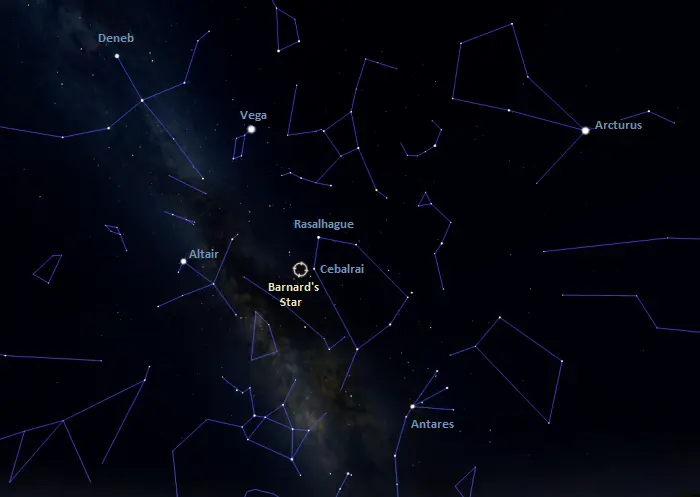
The location of Barnard’s star, image: Stellarium
The orange giant Cebalrai (Beta Ophiuchi) appears to the lower left, or southeast of Rasalhague. Cebalrai can be used to find Poniatowski’s Bull, a faint V-shaped asterism formed by 66, 67, 68, 70, and 73 Ophiuchi. Barnard’s Star appears northwest of 66 Ophiuchi, the rightmost star of the asterism.
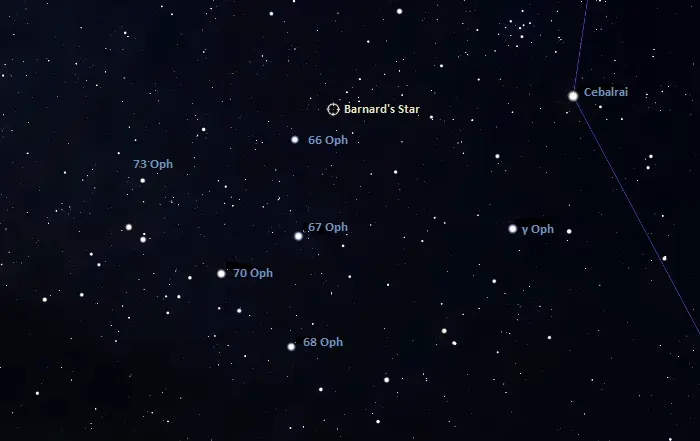
Barnard’s Star and Poniatowski’s Bull, image: Stellarium
The open cluster IC 4665 appears in the same area of the sky, northeast of Cebalrai.
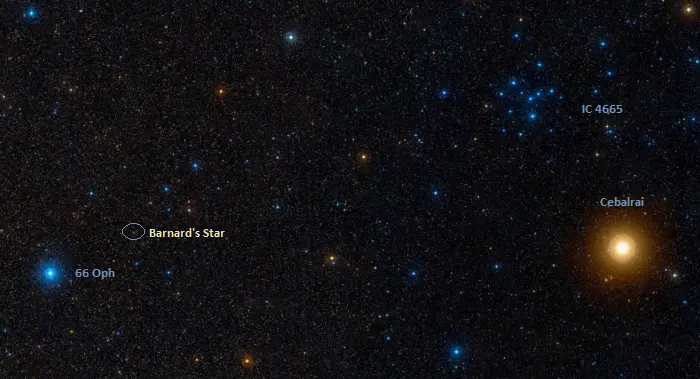
Barnard’s Star, Cebalrai and IC 4665, image: Wikisky
Constellation
Barnard’s Star is located in the constellation Ophiuchus. The Serpent Bearer is one of the 48 ancient constellations catalogued by Claudius Ptolemy of Alexandria in his Almagest in the 2nd century CE.
In Greek mythology, Ophiuchus is associated with the healer Asclepius and is depicted as a man holding a serpent. Rasalhague, the constellation’s brightest star, shines at magnitude 2.07 and marks the Serpent Bearer’s head. Ophiuchus splits the constellation Serpens into two parts: Serpens Caput (the Serpent’s Head) and Serpens Cauda (the Serpent’s Tail).
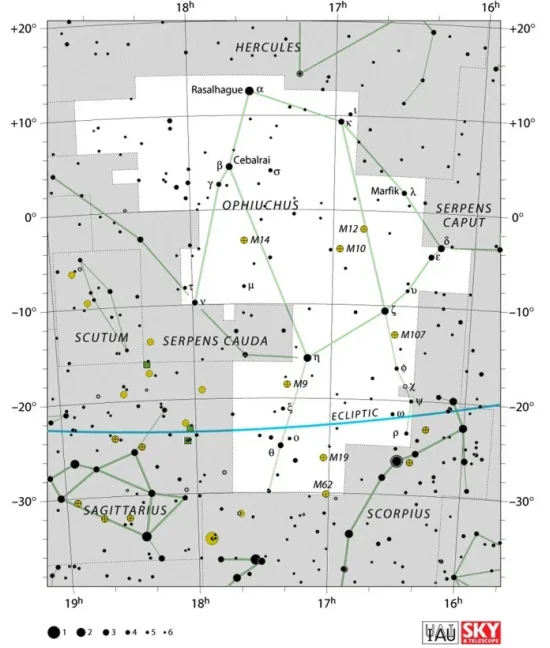
Ophiuchus constellation map by IAU and Sky&Telescope magazine (Roger Sinnott & Rick Fienberg) (CC BY 3.0)
Ophiuchus is the 11th largest constellation in the sky. It lies on the celestial equator and stretches across 948 square degrees of the sky. The constellation is visible from most inhabited places on Earth for at least part of the year.
Ophiuchus contains many notable stars, among them the fast-spinning subgiant Rasalhague (Alpha Ophiuchi), the binary star Eta Ophiuchi (Sabik), the class K giant Cebalrai, the star system Rho Ophiuchi, embedded in one of the nearest star-forming nebulae to Earth, Zeta Ophiuchi, the nearest O-type star to the Sun, the nearby red dwarf Wolf 1061, which hosts three confirmed exoplanets, and the recurrent nova RS Ophiuchi. The constellation is also home to Kepler’s Supernova, the remnant of the supernova SN 1604, observed in 1604.
Ophiuchus is known for its many bright star clusters. These include the open cluster IC 4665 near Cebalrai and the globular clusters Messier 9, Messier 10, Messier 12, Messier 14, Messier 19, Messier 62, and Messier 107.
Other notable deep sky objects in the constellation include the bipolar planetary nebula (M2-9), also known as the Twin Jet Nebula or Minkowski’s Butterfly, the Dark Horse Nebula, a large dark nebula that obscures a part of the Milky Way’s central bulge, and the ultraluminous infrared galaxy (ULIRG) NGC 6240, popularly known as the Starfish Galaxy.
The best time of the year to see the stars and deep sky objects in Ophiuchus is during the month of July, when the constellation is prominent in the evening sky. The entire constellation is visible from locations between the latitudes 80° N and -80° S.
The 10 brightest stars in Ophiuchus are Rasalhague (Alpha Oph, mag. 2.07), Sabik (Eta Oph, mag. 2.43), Zeta Ophiuchi (mag. 2.569), Yed Prior (Delta Oph, mag. 2.75), Cebalrai (Beta Oph, mag. 2.75), Kappa Ophiuchi (mag. 3.20), Yed Posterior (Epsilon Ophiuchi, mag. 3.22), Theta Ophiuchi (mag. 3.26), Nu Ophiuchi (mag. 3.332), and 72 Ophiuchi (mag. 3.73).
Barnard’s Star
| Spectral class | M4.0V |
| Variable type | BY Draconis |
| U-B colour index | 1.257 |
| B-V colour index | 1.713 |
| V-R colour index | 1.213 |
| R-I colour index | 1.557 |
| Apparent magnitude (V) | 9.511 |
| Apparent magnitude (U) | 12.497 |
| Apparent magnitude (B) | 11.240 |
| Apparent magnitude (R) | 8.298 |
| Apparent magnitude (I) | 6.741 |
| Apparent magnitude (J) | 5.24 |
| Apparent magnitude (H) | 4.83 |
| Apparent magnitude (K) | 4.524 |
| Absolute magnitude | 13.21 |
| Distance | 5.9629 ± 0.0004 light-years (1.8282 ± 0.0001 parsecs) |
| Parallax | 546.9759 ± 0.0401 mas |
| Radial velocity | −110.47 ± 0.13 km/s |
| Proper motion | RA: -801.551 ± 0.032 mas/yr |
| Dec.: 10362.394 ± 0.036 mas/yr | |
| Mass | 0.162 ± 0.007 M☉ |
| Luminosity (bolometric) | 0.00340 ± 0.00006 L☉ |
| Luminosity (visual) | 0.0004 L☉ |
| Radius | 0.187 ± 0.001 R☉ |
| Temperature | 3,195 ± 28 K |
| Metallicity | −0.56 ± 0.07 dex |
| Surface gravity | 4.90 ± 0.09 cgs |
| Age | 10 billion years |
| Rotation | 142 ± 9 days |
| Constellation | Ophiuchus |
| Right ascension | 17h 57m 48.4984700685s |
| Declination | +04° 41′ 36.113879676″ |
| Names and designations | Barnard’s Star, Proxima Ophiuchi, Barnard’s Runaway Star, Velox Barnardi, Greyhound of the Skies, V2500 Ophiuchi, HIP 87937, GJ 699, BD+04°3561a, LFT 1385, G 140-024, GAT 12, GCRV 10392, LHS 57, Ci 20 1069, GCTP 4098.00, LTT 15309, NLTT 45718, PLX 4098.00, JP11 18, NSV 9910, Munich 15040, Vyssotsky 799, CNS5 4449, Karmn J17578+046, GEN# +0.00403561, 1E 1755.3+0438, GSC 00425-00184, GSC 00425-02502, MCC 799, AC2000 146626, UBV 15269, CSI+04-17554, CSV 7737, LSPM J1757+0441, PM J17578+0441N, UCAC2 33428712, UCAC4 474-068224, USNO 347, USNO 876, USNO-B1.0 0946-00315199, VVO 6, StKM 2-1355, TIC 325554331, IRAS 17553+0438, 2MASS J17574849+0441405, ASCC 1153178, uvby98 000403561, 8pc 549.01, WISEA J175747.94+044323.8, WEB 14849, Zkh 269, TYC 425-2502-1, Gaia DR2 4472832130942575872, Gaia DR3 4472832130942575872, CCDM J17578+0441A |